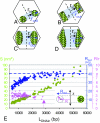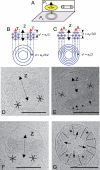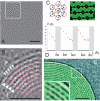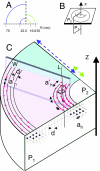Structure of toroidal DNA collapsed inside the phage capsid
- PMID: 19470490
- PMCID: PMC2695091
- DOI: 10.1073/pnas.0901240106
Structure of toroidal DNA collapsed inside the phage capsid
Abstract
The structure of DNA toroids made of individual DNA molecules of various lengths (3,000 to 55,000 bp) was studied, by using partially filled bacteriophage capsids in conjunction with cryoelectron microscopy. The tetravalent cation spermine was diffused through the capsid to condense the DNA under conditions that were chosen to produce a hexagonal packing. Our results demonstrate that the frustration arising between chirality and hexagonal packing leads to the formation of twist walls; the correlation between helices combined with their strong curvature impose variations of the DNA helical pitch.
Conflict of interest statement
The authors declare no conflict of interest.
Figures






References
-
- Gosule LC, Schellman JA. Compact form of DNA induced by spermidine. Nature. 1976;259:333–335. - PubMed
-
- Chattoraj DK, Gosule LC, Schellman A. DNA condensation with polyamines. II. Electron microscopic studies. J Mol Biol. 1978;121:327–337. - PubMed
-
- Widom J, Baldwin RL. Cation-induced toroidal condensation of DNA studies with Co3+(NH3) 6. J Mol Biol. 1980;144:431–453. - PubMed
Publication types
MeSH terms
Substances
LinkOut - more resources
Full Text Sources

